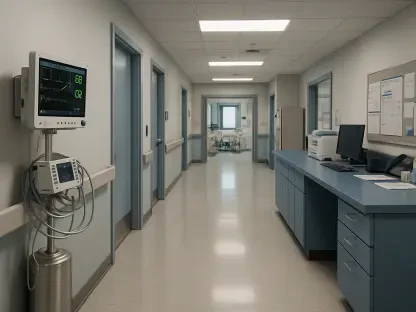In an era where healthcare demands innovative solutions to meet the needs of diverse populations, telemedicine has emerged as a pivotal force, especially for vascular patients grappling with conditions affecting their blood vessels. This technology, leveraging digital platforms like video conferencing and online tools, offers a lifeline to individuals who often face significant barriers to traditional care due to mobility issues or geographic isolation. The ability to consult with specialists from the comfort of home is not just a convenience but a profound shift in how medical services are delivered. For those with vascular diseases, who may struggle with the physical toll of travel or the anxiety of hospital visits, virtual care represents a new frontier. This exploration delves into the multifaceted ways telemedicine is revolutionizing vascular patient care, addressing challenges of access, satisfaction, and equity while paving the way for a more responsive healthcare landscape. It’s a transformation that promises to redefine patient experiences and outcomes in meaningful ways.
Breaking Down Barriers with Accessibility
Telemedicine stands out as a game-changer by eliminating the physical and logistical obstacles that vascular patients often encounter when seeking care. Many individuals with vascular conditions experience pain or mobility limitations that make traveling to a clinic not just difficult, but sometimes impossible. Add to that the challenge of living in rural or remote areas far from specialized medical centers, and the burden becomes even heavier. Through telemedicine, these patients can connect with healthcare providers using nothing more than a smartphone or computer. This means critical consultations, follow-ups, and even initial diagnoses can occur without the need to step outside. The reduction in travel time and associated costs doesn’t just save resources; it also minimizes the risk of exacerbating health issues during transit. As a result, telemedicine ensures that timely medical attention is within reach, fundamentally altering how vascular patients interact with the healthcare system and making care a more seamless part of their daily lives.
Beyond the immediate convenience, the accessibility offered by telemedicine has deeper implications for maintaining consistent care for vascular patients. Regular check-ins with healthcare providers are vital for managing chronic conditions like peripheral artery disease or venous insufficiency, yet frequent in-person visits can be daunting. Virtual platforms enable a continuity of care that was previously out of reach for many, allowing patients to schedule appointments at times that suit their needs without the dread of long journeys. This consistent engagement helps in the early detection of complications, adjusting treatment plans promptly, and preventing emergencies that might arise from neglected symptoms. Moreover, telemedicine can integrate with digital health tools, such as apps for tracking symptoms or medication reminders, further supporting patients in staying on top of their health. By fostering a more connected and responsive relationship between patients and providers, telemedicine lays the groundwork for better long-term management of vascular conditions.
Elevating Patient Satisfaction Through Virtual Care
One of the most notable impacts of telemedicine on vascular patient care is the marked improvement in satisfaction levels reported by those using virtual services. The traditional healthcare model often involves long wait times in clinical settings, which can heighten stress for patients already dealing with chronic pain or discomfort. In contrast, telemedicine offers shorter delays, with appointments often starting promptly via secure video links. Patients also appreciate the ability to discuss their symptoms and concerns in real time while in a familiar, comfortable environment. This setup reduces the intimidation factor of medical facilities and allows for more open communication with providers. Such an experience not only makes patients feel heard but also builds trust in the care process, a crucial element for those managing complex vascular issues where emotional well-being can significantly influence physical health outcomes.
Additionally, the enhanced satisfaction from telemedicine translates into tangible benefits beyond mere comfort for vascular patients. Feeling supported and less anxious about medical interactions often leads to a more positive outlook on managing their condition. This emotional uplift can play a critical role in adherence to treatment protocols, as patients are more likely to follow through with recommendations when they trust the system providing them. Furthermore, the privacy of home-based consultations can encourage more candid discussions about sensitive symptoms or lifestyle factors that might be harder to broach in a clinical setting. For many, this personalized interaction fosters a sense of being valued as an individual rather than just another case, reinforcing their confidence in the healthcare journey. Telemedicine, therefore, doesn’t just streamline appointments—it redefines the patient experience by prioritizing emotional and psychological needs alongside medical care.
Creating Connections Through Referral Dynamics
An intriguing and often overlooked effect of telemedicine in vascular care is its influence on referral patterns within healthcare networks. When patients experience high satisfaction with virtual consultations, they are more inclined to share positive feedback with family, friends, or community members who might also need care. This word-of-mouth endorsement acts as a powerful driver, increasing referral rates to providers who offer telemedicine services. For vascular patients, whose conditions may require specialized attention, such recommendations can be invaluable in helping others find trusted experts. This dynamic not only broadens access to quality care for more individuals but also strengthens the reputation and reach of healthcare providers, creating a virtuous cycle of trust and engagement within the medical community.
Moreover, the referral ripple effect facilitated by telemedicine has broader implications for building robust healthcare ecosystems around vascular care. As more patients connect with providers through virtual platforms and share their positive experiences, the demand for telemedicine services grows, encouraging further investment in these technologies. This can lead to expanded offerings, such as virtual support groups or educational webinars tailored to vascular health, which further enhance patient knowledge and community ties. Additionally, providers benefit from a growing patient base without the overhead costs associated with expanding physical facilities. This organic growth through referrals underscores how telemedicine can serve as a catalyst for not just individual patient outcomes, but also for reshaping how healthcare networks operate, ensuring that more people have pathways to the specialized care they need.
Fostering Empowerment in Health Management
Telemedicine goes beyond facilitating medical consultations by actively empowering vascular patients to take control of their health journeys. With easier access to providers through digital channels, patients can seek advice or clarification on their conditions at critical moments without delay. This direct line of communication builds confidence, as individuals feel more involved in decision-making processes related to their treatment plans. For those with vascular diseases, where lifestyle adjustments and medication adherence are often key to preventing severe complications, this sense of agency is vital. The ability to ask questions or report changes in symptoms in real time via virtual platforms encourages a proactive stance, transforming patients from passive recipients of care into active participants in their wellness strategies.
This empowerment also manifests in improved health outcomes as vascular patients engage more consistently with their care regimens through telemedicine support. The frequent touchpoints enabled by virtual visits allow for ongoing education about managing conditions, whether it’s understanding the importance of diet, exercise, or timely medication intake. Patients who feel equipped with knowledge and supported by accessible providers are more likely to stick to prescribed therapies, reducing the risk of hospital readmissions or emergency interventions. Additionally, telemedicine can integrate tools like wearable devices for monitoring vital signs, providing data that patients and doctors can review together during virtual sessions. This collaborative approach not only reinforces accountability but also helps tailor interventions to individual needs, ensuring that vascular care is both personalized and effective in sustaining long-term health improvements.
Addressing Disparities with Digital Solutions
A profound benefit of telemedicine in vascular patient care lies in its capacity to tackle longstanding healthcare disparities, particularly for underserved populations. Many individuals with vascular conditions live in remote regions or economically challenged areas where access to specialists is limited by distance or financial constraints. Telemedicine bridges these gaps by bringing expert consultations directly to patients, regardless of their location or income level. A simple video call can connect someone in a rural setting with a top vascular surgeon hundreds of miles away, ensuring that critical care isn’t dictated by geography. This democratization of access is a significant step toward health equity, allowing those who might otherwise forgo treatment due to barriers to receive the attention they need to manage their conditions effectively.
Furthermore, reducing disparities through telemedicine also involves addressing cultural and systemic issues that often hinder care for vascular patients in marginalized communities. Virtual platforms can offer language translation services or culturally sensitive care approaches, making interactions more inclusive and effective. Additionally, the cost savings from avoiding travel and in-person visit fees can make a substantial difference for low-income patients, enabling them to allocate resources to other health needs like medications or healthy food choices. However, to fully realize this potential, efforts must focus on ensuring that internet access and digital devices are available to all, alongside education on using these tools. By prioritizing such inclusivity, telemedicine can become a cornerstone in leveling the playing field, ensuring that quality vascular care reaches every corner of society, regardless of socioeconomic or geographic challenges.
Overcoming Obstacles in Telemedicine Adoption
While telemedicine offers transformative benefits for vascular patient care, it’s not without significant challenges that must be addressed to ensure widespread success. Technical issues, such as unreliable internet connections or outdated devices, can disrupt virtual consultations, leaving patients frustrated and potentially delaying critical care. This is particularly problematic in areas where broadband infrastructure is lacking, often overlapping with the very regions telemedicine aims to serve. Additionally, some vascular patients, especially older adults, may struggle with digital literacy, finding it difficult to navigate telehealth platforms without assistance. These barriers can undermine the effectiveness of virtual care, highlighting the need for robust support systems to help patients adapt to this mode of healthcare delivery and ensure no one is left behind in the shift to digital solutions.
To mitigate these obstacles, targeted interventions are essential for making telemedicine a viable option for all vascular patients. Initiatives like community-based tech training programs can empower those unfamiliar with digital tools, teaching them how to join video calls or use health apps confidently. Simultaneously, healthcare providers and policymakers must advocate for expanded internet access, perhaps through subsidies or partnerships with tech companies to provide affordable connectivity. Offering tech support hotlines or step-by-step guides during onboarding can also ease the transition for patients facing technical hiccups. By addressing these challenges head-on, the healthcare system can ensure that the benefits of telemedicine—accessibility, satisfaction, and equity—are not limited to a tech-savvy few but are extended to every individual in need of vascular care, fostering a more inclusive approach to medical advancements.
Shaping the Future of Vascular Healthcare
Reflecting on the journey of telemedicine in vascular patient care, it’s clear that this technology has already begun to redefine access and engagement in profound ways by addressing critical barriers such as travel difficulties and long wait times. The strides made in boosting patient satisfaction demonstrate how virtual care can alleviate not just physical burdens but also emotional stress, while the unexpected boost in referrals shows its potential to organically expand healthcare networks. Empowerment has emerged as a cornerstone, with patients taking active roles in their treatment, supported by consistent virtual interactions. Moreover, efforts to bridge healthcare disparities through digital access mark a significant push toward equity, even as technical challenges remind stakeholders of the work still needed to ensure inclusivity.
Looking ahead, the next steps for telemedicine in vascular care involve a commitment to innovation and accessibility to sustain and build on past achievements. Investment in user-friendly platforms and integration with wearable health technologies could enhance real-time monitoring, making virtual care even more responsive. Expanding digital infrastructure to underserved areas remains a priority to ensure no patient is excluded due to connectivity issues. Additionally, ongoing education for both patients and providers about telemedicine tools will be crucial in maintaining trust and efficacy in virtual interactions. As the healthcare landscape continues to evolve, these actionable strategies offer a roadmap for embedding telemedicine as a permanent, transformative element in vascular care, promising a future where every patient can access tailored, high-quality treatment regardless of circumstance.









